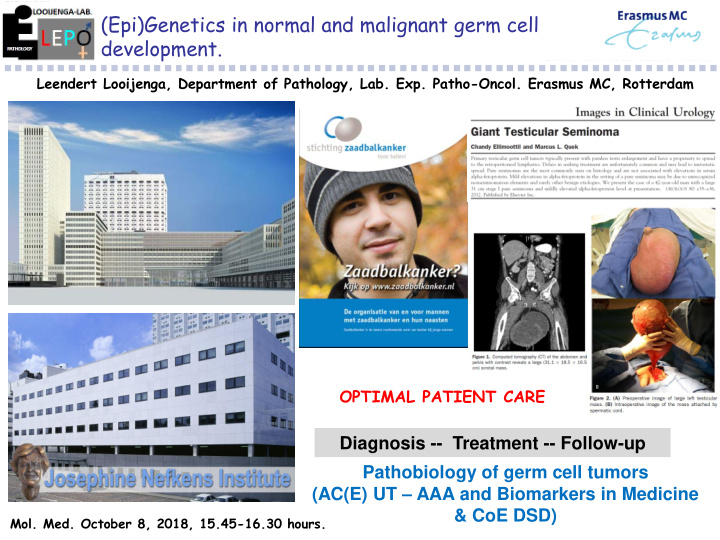



(Epi)Genetics in normal and malignant germ cell development. Leendert Looijenga, Department of Pathology, Lab. Exp. Patho-Oncol. Erasmus MC, Rotterdam OPTIMAL PATIENT CARE Diagnosis -- Treatment -- Follow-up Pathobiology of germ cell tumors (AC(E) UT – AAA and Biomarkers in Medicine & CoE DSD) Mol. Med. October 8, 2018, 15.45-16.30 hours.
Me + LEPO (Looijenga’s eigen pathologie onderneming) PhD co-promotor 2 /promotor 12/ongoing 9 = 23 Invited speaker 254; Funded research projects 50 Papers: 1st 39/co 154/last 124 = 317 LEPO Book chapters etc. 25
Traditional pathology classifications Many reasons to adjust (no biology included)
Germ cell lineage- defined cohorts DMRT1 OCT3/4-AP KITLG-KIT Germ cell neoplasia dependent on cell of origin
Animation: Introduction. www.erasmusmc.nl/pathologie/research/lepo
Animation: Introduction .
Animation: Embryonic germ cell loss (< 6 months).
Classification GCTs (complex: NO). WHO 2016 Oosterhuis and Looijenga, Nat Rev Cancer 2005; Nat Rev Dis Primers 2018 in press; update 2018 in prep.
Precursor classification: WHO 2016 type II GCT. PRECURSOR TERMINOLOGY CIS - (TIN) - IGCNU
Overview current status: epidemiology.
Type II (= malignant TGCTs): Epidemiology. GENERAL POPULATION OBSERVATIONS Historical (main) risk factors: - Cryptorchidism - Sub/infertility - Familial predisposition TDS - Inguinal hernia - Birth weight - Hypospadias - DSD – (intersex) (THEORETICAL) ASSUMPTION: ALL (??????) High curability (>90%), but long term systemic treatment effect: Infertility, Metabolic Syndrome, Vasc./Heart Damage, 2 nd Cancers
Overview pathology GCNIS related TGCT. COMMON PRECURSOR Blocked PGC/gonocyte PRE-INVASIVE: ( EMBRYONIC GERM CELL) Early gonadal development GCNIS (GB-DSD) seminoma embr. carc. 70% ~ 7 years INTRATUBULAR: INVASIVE: PLURIPOTENT (TOTI-/OMNI-) seminoma embr.carc. germ cells PURE or MIXED yolk sac tum. teratoma choriocarc.
Overview pathology & biomarkers (serum); selection. COMMON PRECURSOR OCT3/4 Blocked PGC/gonocyte PRE-INVASIVE: ( EMBRYONIC GERM CELL) Early gonadal development GCNIS (GB-DSD) seminoma embr. carc. OCT3/4 OCT3/4 70% ~ 7 years INTRATUBULAR: OCT3/4 OCT3/4 INVASIVE: PLURIPOTENT (TOTI-/OMNI-) seminoma embr.carc. germ cells Palumbo et al., 2001; Looijenga et al., 2003, De Jong et al., 2005, Cheng et al., AFP hCG 2006; De Jong and Looijenga, 2007, Van Casteren et al., 2008a,b, 2009, De Jong et al., 2008, Nonaka et al., 2009, Sonne et al, 2010, Gillis et al., 2011, Ushida et al., yolk sac tum. teratoma choriocarc. 2012, Eini et al., 2014, and many others.
Overview pathology & biomarkers (serum); selection. COMMON PRECURSOR OCT3/4 OCT3/4 SOX17 Blocked PGC/gonocyte PRE-INVASIVE: ( EMBRYONIC GERM CELL) Early gonadal development GCNIS (GB-DSD) seminoma embr. carc. OCT3/4 OCT3/4 OCT3/4 OCT3/4 70% SOX17 SOX2 ~ 7 years INTRATUBULAR: OCT3/4 OCT3/4 OCT3/4 OCT3/4 INVASIVE: SOX17 SOX2 PLURIPOTENT SOX17 (TOTI-/OMNI-) seminoma embr.carc. germ cells Palumbo et al., 2001; Looijenga et al., 2003, De Jong et al., 2005, Cheng et al., AFP SOX2 hCG 2006; De Jong and Looijenga, 2007, Van Casteren et al., 2008a,b, 2009, De Jong et al., 2008, Nonaka et al., 2009, Sonne et al, 2010, Gillis et al., 2011, Ushida et al., yolk sac tum. teratoma choriocarc. 2012, Eini et al., 2014, and many others.
SOX2 and 17 critical ES resp. PGC
Biomarkers (WHO 2106) and dAP (PGC/ES). Similar (protein) patterns normal development & (T)GCTs (highly informative diagnostic markers)
Chromosomal/genetic constitution (GBY - TSPY) GBY: Page 1987 TSPY: Schnieders et al ., 1996; Lau et al ., 1999; Hildenbrand et al ., 1999; Lau et al ., 2000; Schubert et al ., 2003; Kersemaekers et al., 2005, … No co-expression normal germ cells Abundant expression GCNIS/GB Predominant loss upon invasive growth, adult GCNIS can be heterogeneous GCNIS/intrat. NS/NS Embryo 27 wks Adult GCNIS (OCT3/4 + TSPY) (OCT3/4 + TSPY) X
DSD and GCTs (towards a clinical decision tree). DSD = “INTERSEX” Chicago Consensus meeting October 2005 Risk overdiagnosis early age (<1 y): delayed maturation versus (pre-GCNIS) [OCT3/4 +]
Discriminate delayed maturation and (pre-)GCNIS. Stoop et al., 2008 OCT3/4 and SCF (KITLG): Distinction between delayed matured and (pre-)GCNIS -- versus ++ Wolffenbuttel et al ., 2016
GWAS and TGCC Rapley et al., 2009; Kanetsky et al. 2009; Turnbull et al. 2010; Kratz et al., 2011; Ruark et al., 2013; Chung et al., 2013. + KITLG [OR = 2.69 highest to date] + SPRY4 [inh. MAPK, downstream KITLG] + BAK1 [downstream KITLG] + DMRT1 [sex determination] + TERT, ATFIP [telomere maintenance] + UCK2, HPGDS, CENPE, CLPTM1L, MAD1L1, RFWD3, TEX14, PPM1E Risk alleles are the major alleles (lower in Asian & African = low risk (T)GCC) Independent: Cryptorchidism; fam. predisposition, spermatogenic function < 1% of patients carry low risk KITLG allele < 3% of patients carry low risk DMRT1 allele double homozygous high risk alleles SUSCEPTIBILITY ALLELE(S) KITLG + DMRT1 ( 28X TGCC)
TECAC - SNP update TGCT.
DSD and TGCT related SNPs.
Current model early pathogenetic step(s).
Recommend
More recommend